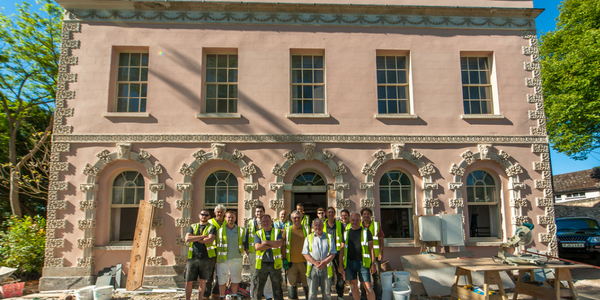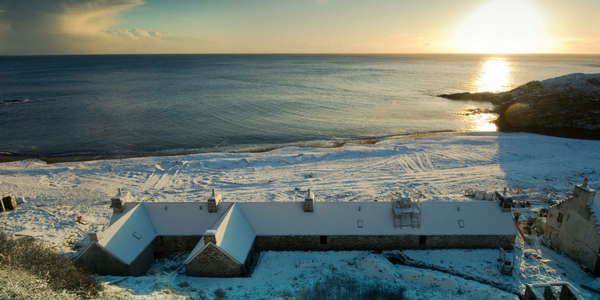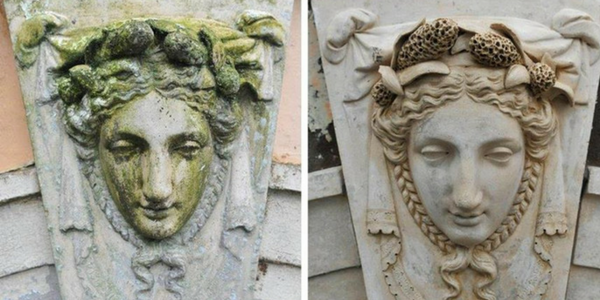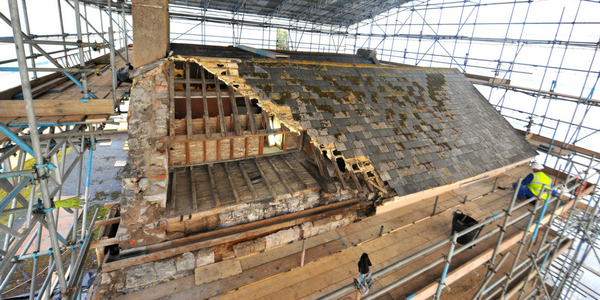 The team on site at Belmont
The team on site at Belmont
September 2013 saw the start of a major restoration project at Belmont, our 18th-century maritime villa in Lyme Regis. During the long planning stage of the project it was decided that the restoration could be carried out "in house" by Landmark, with Carole Paton, the Regional Building Surveyor taking the role of Project Manager and myself as Site Manager. This as expected caused great excitement and was a huge honour for me to be involved in such a high profile and important restoration.
The simple idea behind this approach was to keep complete control of the design element and quality of work needed to do justice to such an extraordinary building. My previous experience managing a Landmark restoration came in the form of the Shore Cottages in Berriedale, Caithness, right at the Northern tip of Scotland.
The Berriedale Shore cottages stand at a polar opposite to Belmont, not just geographically (nearly 700 miles apart!) but also in almost every other aspect of their design and use. The Shore cottages are very humble compared to Belmont and they embody much of the history of Caithness. The approach was as always with our work, to carry it out with sensitivity and appreciation for what has gone before. This is comes in the form of using the correct materials and historic techniques to extend the life of our buildings. When I look at an historic building I can almost see it being built in my mind and feel an immense privilege to carry on where master craftsmen, who are now long gone, have left off. That is always something that fills me with pride.
The experience and difficulties you face on a project always hold you in good stead for the next challenge. Berriedale had lots of challenges, not to mention crossing a river to get to the site. This minor 'hurdle' was solved by building a boat to transport hundreds of tonnes of materials including slates, timber, stone, sand, basically everything!
 The Shore Cottages, Berriedale
The Shore Cottages, Berriedale
So back to Belmont: We all knew that underneath various extensions and add-ons throughout its life there was a very grand Georgian building underneath. Our first task was to carefully remove poorly constructed extensions and alterations. This meant isolating the Victorian observation tower from the main building. The Tower was built over 100 years after the main house and is a fine example of Victorian architecture and with its own rotating roof. Work started to restore the workings using a local U3A group who eagerly grasped the opportunity to help. This group consisted of mainly retired engineers and professionals with immense knowledge and good humour. This was one of the highlights of the project for me.
After the removal of the extensions work began under a huge covered scaffold to start the rebuild and replacement of the main roof.
We worked with local contractors on all the different elements and they were a team of highly motivated and skilled craftspeople. We also had the opportunity to employ a local chap as our site labourer who very quickly proved himself to be a talented and trustworthy individual. His name was Bill Barclay and he is now is Landmark's full time craft apprentice and doing a level 3 NVQ in traditional carpentry.
The craftspeople all showed a high level of dedication and ownership of Belmont. The high level of pride was palpable, as was a clear understanding of the historical and architectural importance of the building, and admiration for the wonderful lady whose home Belmont was, Eleanor Coade.
Things did go wrong, as with all projects, and frustrations did arise, but I remember saying on more than one occasion, "Just look at where we are and what we are doing" that would be greeted with a quiet nod and smile and a renewed determination to solve the problem at hand.
 Coade stone - before and after cleaning
Coade stone - before and after cleaning
There were many challenges on Belmont at all the different stages of the restoration but the main one happened quite early on. This was when we were at the dismantling of the later additions to the building. When later extensions were added extensive work had been done internally to open up areas of the rear elevation. This was in the form of knocking walls down, moving doorways and windows. We of course wanted to reverse this action and restore the building to its original, 18th-centry layout. The work required careful planning and preparation. A lot of propping and supports were needed to keep the building upright but were successful so that rebuilding could begin.
We had excellent research carried out on the building, led by Landmark's brilliant Historian Caroline Stanford and a fine set of architectural drawings which gave us assurance that the building was being put back correctly. I often wondered if Eleanor Coade would recognise the building if she could see it inside and out, I was confident the answer was yes. Every room layout and every colour, such as the confectionary pink exterior and the pea-green hallway, were meticulously thought about with a level of detail that was incredible.
We stayed on site for the first year or so of the project in one of the many extensions. We decided this would be sensible as we were working away from home (Stockport!) and there was a usable space to live in. When we took it down we could join up all the work and could see the finish. Things onsite got more exciting the closer we came to the end: Coade stone was repaired, new gate piers were made in Coade by probably the country's leading expert in the field, Phil Thomason. We were incredibly lucky as his workshops and kiln were in Somerset about 20 minutes' drive from site. All the joinery items arrived, windows and doors. A bespoke kitchen was made by our own fabulous joiners, Mark Smitten and Luke Rose at a workshops in the Cotswolds, typically late-Georgian paint colours began appearing on walls and eventually furniture began to arrive.
 Restoring Belmont's roof
Restoring Belmont's roof
This marked a return to living on site, but now in the grand surroundings of the main house, albeit temporarily until it opened to Landmarkers in September 2015. Long 12 or 13 hour days were needed to bring the project to a finish and everyone involved was willing and happy to get the job done.
When the time came to hand over the keys to Marilyn Donohue, the Regional Property Manager, the sense of achievement and pride was almost overwhelming. Working at Belmont for the two years it took to restore was the best professional experience I have ever had. I'm not sure it will ever be beaten.